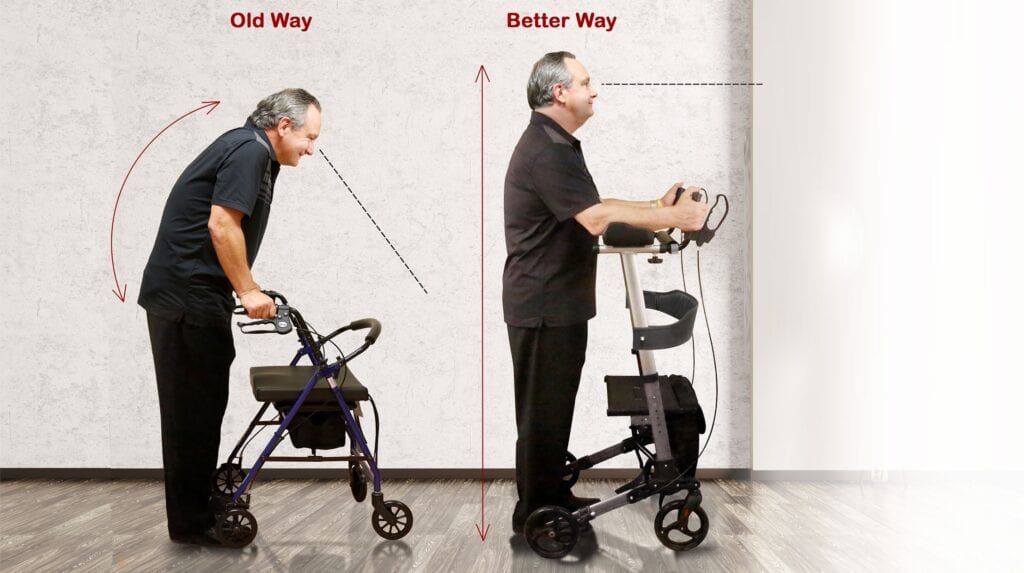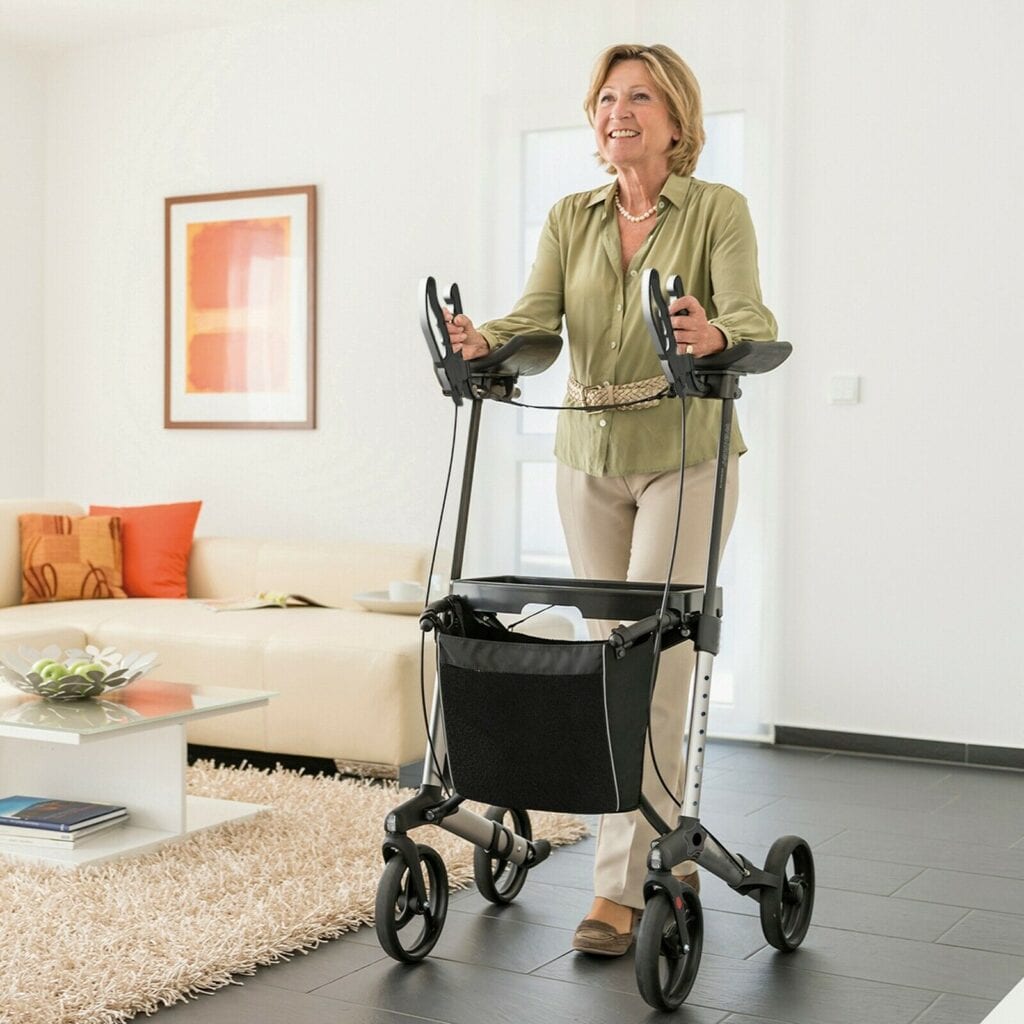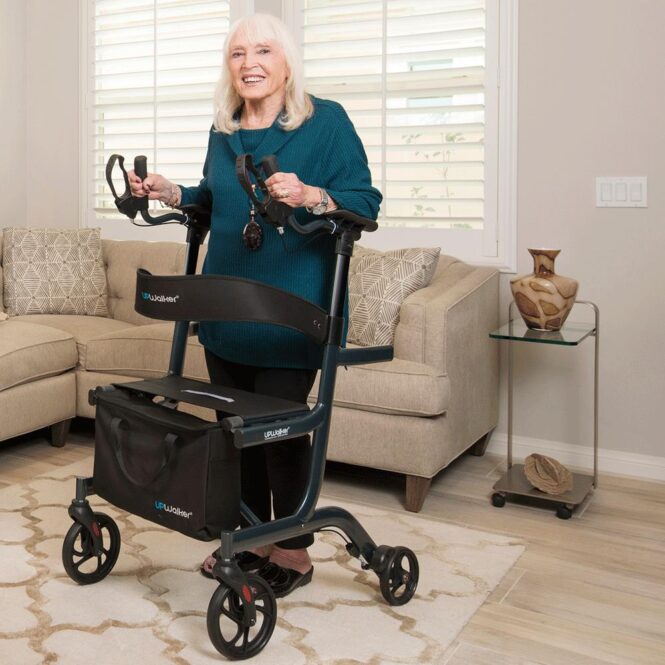Progressively-worsening back pain can reach a level of severity where calling out sick from work or visiting a doctor becomes mandatory. Unbeknownst to most, chronic back pain is the leading cause of disability worldwide, especially for senior citizens.
Back pain can intensify when bending or moving abruptly, making moving from place-to-place difficult. Fortunately, there is a wide range of mobility aids that can help you maintain a sense of independence and freedom. If you have a back problem that affects your ability to walk correctly or undergo spine surgery, using a mobility chair can help you regain stability with ease.
With a simple design, walkers can benefit the physically disabled by relieving pressure from their back, preventing falls, and improving their balance. However, not all mobility aids are created equal. Traditional walkers are infamous for exacerbating current back pain, as they contort your body into a hunch. Luckily, innovations in upright walkers grant you the freedom to choose. So, if you or someone you love requires a mobility aid, read on to understand which device is best suited to your needs. Mobility devices such as The Perfect Walker can reinstate the physically-disabled with a long-awaited sense of independence.
Traditional wheelchair vs. upright walkers

The traditional walker and the modern upright walker share their mobility-aid functions and are both designed for seniors, those facing musculoskeletal problems, or those recovering from a physically-debilitating illness. However, the two also have significant differences in terms of size, effort, and posture.
Size
In terms of size, traditional devices tend to be bigger and bulkier. When stored, its frames fold inwards, which results in an awkwardly-large mobility aid that’s difficult to store. Worst of all, when folded, a traditional product must be leaned against a wall or another sturdy object, as it’s unable to support itself.
Its size makes it both difficult to store and transport a traditional mobility aid. With these inconveniences in mind, a traditional device is more burdensome than the competing upright walker model, especially to those with spinal conditions. Unlike a traditional option, an upright walker is compact and easily storable. With ease, you can fold an upright walker and allow it to stand on its own. Additionally, it’s easy to carry around on-the-go and doesn’t need to be leaned on a sturdy object when folded.
Effort
When using a traditional product, you must exert maximum energy, as the user must physically lift the device each time they take a step. When a physically-disabled person lifts equipment, they are more susceptible to further injury, especially if they’re experiencing severe discomfort or don’t have enough physical strength for lifting.
Unfortunately, many users operate the traditional wheelchair incorrectly, either due to lack of knowledge or because of the device’s complicated nature. Most traditional models require users to coordinate both the arms and feet, which can be tricky for those disabled folks already struggling with stability. Improper usage can also lead to strained arms and bad posture, which can aggravate existing back problems.
On the other hand, upright walkers require minimal effort to operate. They are designed to enhance user confidence, address slouching, reduce fall risk, and improve comfort. Most models on-the-market come with adjustable handles and armrests that enable your loved ones to stand straight and look ahead, offering more stability and support. Its front wheels and the gliders at the back allow you to push the device as you move, meaning you don’t need to lift the device when moving — unlike other conventional products.
Posture
A traditional option forces you to move with a hunch. Because you’re required to lift the equipment whenever you’re taking a step and coordinate your arm movements with your feet movements, this can contribute to hunched back over time.
With an upright walker, all you need to do is push the device forward in an upright standing position when moving. The device also has maneuverable wheels and adjustable armrests that you can adjust to your preferred heights. An upright walker is the ideal mobility aid for those users with shifting needs, i.e., a condition that may worsen over time and restrict a senior’s mobility even further.
Health benefits of using an upright mobility aid

Unlike the traditional walker, which is associated with back problems, an upright walker has several health benefits including the following;
Improves comfort and posture
In recent years, engineers revolutionized the walker to improve the comfort and posture of its operators. In the effort to promote good posture, the upright walker incorporates comfortable and adjustable armrests to support your right and left sides. Additionally, this mobility aid includes a lockable braking unit in front of the device, so you can be fully in control of the equipment when you move around. If you have reached your destination or want to rest, you can lock your unit’s rear wheels and sit to recoup. Most importantly, the product includes a backrest made of mesh to enhance breathability that supports your back as you sit, reducing back strain and pain.
Reduces back pain
Unlike the traditional options that force you to bend forward, placing painful pressure on your wrists, muscles, back, and joints, the upright walker promotes an upright posture. Medical experts believe poor posture can cause adverse mental and physical health conditions such as spine damage, discomfort, and low self-esteem. On the other hand, good posture can reduce back pain, risk of injury, lower fatigue, and improve balance and breathing.
The modern upright walker resolves any problems associated with traditional mobility aids. Its additional features help support and secure an upright position to enhance the user’s sense of independence and comfort.
Customization
A traditional device isn’t adjusted accordingly to suit a user’s specific needs, increasing slouching. The lack of adjustable features makes the device less practical, especially for those with shifting medical needs. Sadly, a traditional option comes as a significant hindrance to maneuverability, as many people shop for an adjustable walker that can better suit their growing medical or personal needs.
The good news is that the upright walker helps bridge this gap. This modernized device provides flexible features that allow for customization to meet a specific user’s increasing needs while improving comfort.
Suitable for both indoor and outdoor use
With flexible features, an upright walker is an ideal solution for both indoor and outdoor mobility needs. It allows for user-friendly handling along with effortless maneuverability in tighter areas in your house, making indoor tasks a breeze. Similarly, an upright walker prioritizes your safety outdoors. Its modern, flexible, and large wheels can navigate uneven surfaces and rough terrains with ease, significantly reducing your risk of injuries and falls.
Ideally, the revolutionary upright walker will eliminate all the inconveniences associated with limited mobility and allow you to shop, attend social events, travel, exercise, and live your daily life without restrictions. Being able to enjoy your everyday life freely can enhance a physically disabled person’s quality of life and reduce the risk of sustaining further injury.
How to know it’s time to start using a mobility aid

Frequent falls
Frequent falls occur as a result of instability. If you start losing balance, and it becomes hard for you to maintain stability, this may indicate the need for a mobility aid. If you worry about you or your loved ones tumbling down the stairs, tripping over unlevel surfaces, or slipping unexpectedly, investing in a mobility aid, like an upright walker, can grant you peace of mind.
Inability to walk
Suppose you underwent surgery several months ago but are still unable to move without assistance or don’t have enough energy to travel from place to place physically. In that case, the next step should be to purchase a mobility aid. Don’t deplete your energy levels when it isn’t necessary.
Medical reasons
You may also need to use a mobility aid if your doctor recommends that you start using one to promote an upright position or enhance stability lost due to a particular medical condition.
Conclusion
Typically, both the traditional wheelchair and upright walker aim to address your mobility restrictions. When shopping, be sure to choose a device that meets your specific needs. Sadly, standard options often lack customizable features to accommodate the users’ changing personal or medical needs. Fortunately, the upright walker comes with flexible and comfortable features to meet every user’s unique needs.
 Imagup General Magazine 2024
Imagup General Magazine 2024



